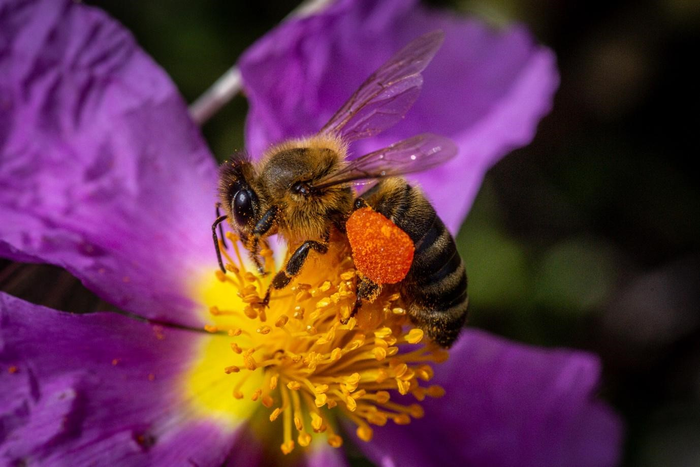Researchers at Greece’s B.S.R.C. “Alexander Fleming” has perfected a method for identifying DNA traces in honey, indicating the species with which honeybees interact. This interdisciplinary effort, led by researcher Dr Solenn Patalano, allowed for year-round monitoring of bee food variations, the non-invasive discovery of bee microbiota, and the identification of pathogenic species they encounter.
 Honeybee harvesting pollen and carrying it to its pollen basket”. Image Credit: Yannis Varouhakis (instagram.com/varouhakis).
Honeybee harvesting pollen and carrying it to its pollen basket”. Image Credit: Yannis Varouhakis (instagram.com/varouhakis).
The work was published in the journal Molecular Ecology Resources, and while it is still in the early stages of research, it has the potential to revolutionize the understanding of honeybee ecological niches.
Why understanding honeybee ecological niche is important?
The precise balance of interactions and adaptations to other species coexisting within the same habitat is what determines an organism’s ecological niche. Honeybees make use of a huge variety of flowering plant species for their food and development by pollinating trees and flowers. On the other side, when environmental circumstances favor the spread of harmful species like Varroa mites, honeybee colonies are weakened.
The honeybee ecological niche’s species dynamics are therefore intricately related to the type of the environment in which the bees live and its seasonal fluctuations.
Bee ecological niches are becoming increasingly fragile as agricultural regions are restructured and the consequences of climate change are seen. Greater knowledge of the dynamics of interactions between bees and their environment would aid in the identification of bee danger times and zones.
This is extremely important in rural and agricultural environments, where species interactions influence the productivity of crops. It's compelling how much of our food and survival depends on the proper functioning of tiny insects!”
Anastasios Galanis, Study First Author, Institute for Fundamental Biomedical Research, Biomedical Sciences Research Center Alexander Fleming
Honey, a unique marker of environmental plant diversity
Honey is made by honeybees regurgitating nectar and pollen from the flowers they forage and storing it in their hive’s cells until enough water evaporates. Honey comes into touch with a range of creatures throughout this process and hence includes DNA from different species, referred to as environmental DNA (eDNA), which comes from foraged plants, bee gut bacteria, and possible hive infections.
The “direct-shotgun metagenomics” approach, which has already been published and optimized, entails sequencing and detailed characterization of the eDNA fragments detected in honey.
The design and testing of a bioinformatic pipeline tuned for honey metagenomic data allows us to increase sensitivity and specificity; thus, we can be quite confident about the identification of certain species.”
Anastasios Galanis, Study First Author, Institute for Fundamental Biomedical Research, Biomedical Sciences Research Center Alexander Fleming
Researchers examined various samples of honey from an apiary in a typical Mediterranean area for this investigation. Scientists discovered almost 40 plant species that represent the vast botanical variety that surrounds the hives.
What was very striking, is to see how variable the abundance of plant eDNA is over the seasons, reflecting perfectly the behavioral foraging adaptations that follow plant flowering.”
Dr Solenn Patalano, Institute for Fundamental Biomedical Research, Biomedical Sciences Research Center Alexander Fleming
Researchers also used melissopalinology to compare various honey samples (using the shape of pollen grains for characterization). Aside from the two methods’ strong complementarity, the study found that the metagenomic technique also discloses non-pollen foraging behavior, such as pine honeydew foraging, an essential food source for bee survival in early fall.
Anticipating disease and spread of pathogens
Bees’ existing species, contrary to popular belief, go much beyond plants. The researchers discovered an even higher number of bacterial eDNA species in the honey samples they studied, the vast majority of which comes from harmless microbes that make up the bee microbiome’s core species.
Dr Patalano states, “Like the human gut microbiome, the gut microbiome of the bee is an important element of their health. We already know that environmental stressors, such as pesticides, can seriously damage gut microbial communities and increase the risk of bee diseases. But how this works remains largely unknown.”
The researchers show that using honey metagenomics to examine gut microbiome diversity without harming bees is possible.
The presence of eDNA from suspected pathogens was also investigated. Scientists discovered that Varroa mite eDNA in honey corresponded to reported hive contamination. These findings might someday be used to monitor and predict disease and infections in large-scale investigations, which is a hopeful indication.
“In the future, this work might also have very important implications for humans. If we want to ensure ecosystem services, such as fruit and vegetable pollination, while maintaining species biodiversity, we also need to safeguard bee health. Our challenge is to build biomonitoring strategies in order to identify the fittest ecological niches for all pollinators”, Dr Patalano concludes.
Source:
Journal reference:
Galanis, A., et al. (2022) Bee foraging preferences, microbiota and pathogens revealed by direct shotgun metagenomics of honey. Molecular Ecology Resources. doi.org/10.1111/1755-0998.13626.